
Features
Crop Culture
Research
Vegetables
In the hot house: How high temperatures impact greenhouse tomato fruit development
High temperatures can lead to physiological disorders such as fruit cracking, green shoulder, sunscald and goldspot.
May 26, 2022 By Dr. Fadi Al-Daoud and Dr. Xiuming Hao
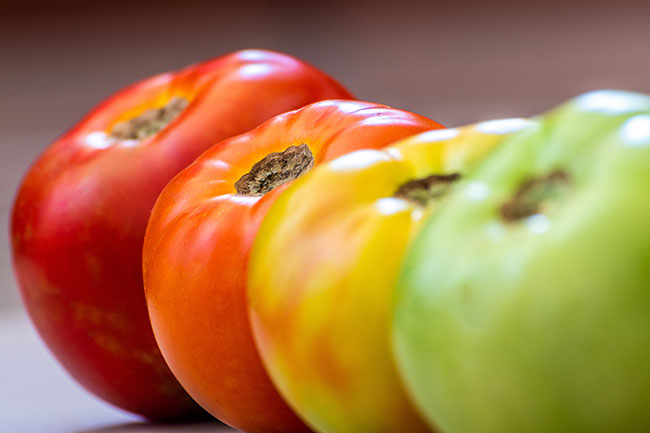 PHOTO courtesy of Debbie Ann Powell/ADOBE
PHOTO courtesy of Debbie Ann Powell/ADOBE In the dog days of summer, temperatures in Ontario vegetable greenhouses can surpass 30 °C for days on end. Understanding how such high temperatures affect the growth and development of greenhouse crops is an important first step in learning how to grow vegetables in hot greenhouse conditions.
Tomato fruit development and maturation
Development of the tomato fruit can be divided into three main stages.
Stage 1 is characterized by cell division that occurs within 10 days after fertilization. This is followed by Stage 2 between 10 to 40 days after fertilization when cells grow and expand. The final stage, Stage 3, includes ripening and maturation of the fruit after it has reached its final size.
Dramatic metabolic changes occur as the tomato fruit develops from a green organ able to undergo photosynthesis, to a red fruit that is full of sugars, organic acids, vitamins A, B and C, lycopene and potassium. These compounds accumulate in the fruit at different stages of development. For example, organic acids and starch accumulate during Stage 2 and in the early phases of Stage 3. Whereas during the final stages of ripening in Stage 3, organic acid and starch levels drop, and sugar and lycopene levels increase.
The colour change that occurs during late maturation is partly the result of the chloroplasts in the cells (which give the fruit its green colour and are responsible for photosynthesis) changing into chromoplasts (which store carotenoids including lycopene that give the fruit its red colour). The maturation of tomato fruit is influenced by a number of plant hormones including ethylene, auxin, abscisic acid, and brassinosteroids. Some of these phytohormones promote fruit ripening (ethylene, abscisic acid, and brassinosteroids) while other inhibit it (auxin). Hormone levels also change with fruit development. Stage 1 is characterized by an increase in auxin levels, Stage 2 is associated with an increase in abscisic acid levels, whereas ethylene accumulates during the final phases of fruit maturation and ripening in Stage 3. In fact, there is a dramatic 100 to 300 times increase in ethylene production and respiration rate as the tomato fruit matures. These ethylene-dependent changes allow tomatoes to mature and ripen after harvest, and that is why tomatoes are known as “climacteric fruit.” Non-climacteric fruits, like strawberries, do not mature after harvest.
High temperatures
High temperatures affect each stage of tomato fruit development.
If greenhouse temperatures surpass 30 °C, fertilization fails and fruit set is reduced in Stage 1. Fruit development in Stage 2 and fruit ripening in Stage 3 also suffer under these conditions leading to the development of a number of physiological disorders. These disorders include fruit cracking, green shoulder, sunscald, and goldspot.
Heat stress increases respiration rate and decreases photosynthesis in the plant as a whole. High temperatures and direct sunlight also alter the development of chromoplasts that store lycopene, and they directly reduce the level of lycopene (red colour) in the fruit by stimulating its conversion into β-carotene (yellow colour). Lycopene formation is inhibited if temperatures are over 30 °C, whereas production of β-carotene continues up to 40 °C. This leads to accumulation of carotene and reduction of lycopene in high heat.
Besides high temperatures, direct sunlight irradiation during the summertime also plays a role in abnormal maturation of tomato fruit. Direct exposure to high sunlight levels by the fruit may increase the temperature of fruit tissue by 10 ºC or more above ambient air temperature. A few hours at 30 ºC will prevent normal pigment synthesis, reducing its lycopene levels. Fruit temperatures above
40 ºC are lethal and the exposed tissue will die, turn white, dry out and form a flat parchment-like covering over the affected area.
Fruit cracking
There are three types of fruit cracking.
- Radial fruit cracking (RFC) occurs when deep cracks jet from the calyx (stem) and down the fruit
- Cuticular cracking occurs when fine cracks appear in the surface of the fruit, and
- Skin cracking occurs just before harvesting in the pericarp surface (fleshy part of the tomato fruit).
Of these different types of cracking, RFC causes the most problems for producers because it spreads down the fruit during fruit development. Serious RFC will render fruit unfit for sale and they are discarded.
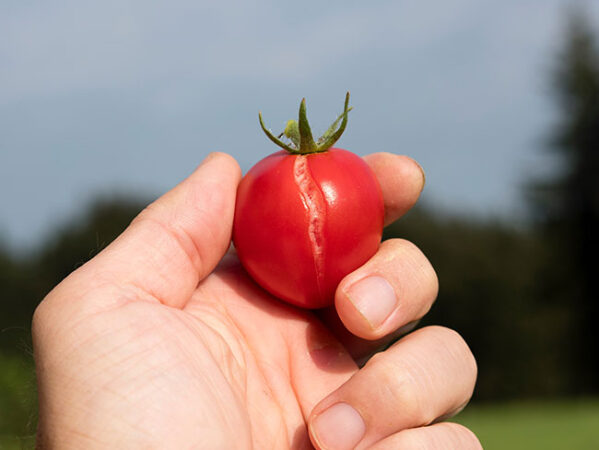
Fruit cracking can result from sudden temperature changes. PHOTO courtesy of Floki/ADOBE
RFC occurs inside the cells of the pericarp rather than in the intercellular space (between cells). It is thought to be due to excess water and sugars flowing into the growing fruit, compromising cell structure and integrity and causing cells to rupture under the force. The risk of RFC increases if air temperatures in greenhouses exceed 25 °C during early fruit development. As air temperature rises it slows the rate of fruit cell division and growth resulting in fewer and smaller cells than under cooler temperatures. But since water and sugars are still being actively imported into these slowly growing fruits the turgor pressure becomes more than what the fruit cells can handle, which makes them more susceptible to RFC. Besides temperature, humidity is also correlated with RFC. The bigger the difference in humidity levels inside the greenhouse during the day and night, the higher the chances of RFC.
Sudden temperature changes or high day/night temperature variation will favour the cracking of fruit. Changes from night to day temperature need to be made before sunrise in order to avoid water vapor condensation on fruit. Low night temperature favours a negative pressure in fruit, whereas high day temperature increases both gas and hydrostatic pressure of fruit pulp on the skin, resulting in the cracking of ripe fruit.
There is also a relationship between plant nutrition and fruit cracking. Studies have shown that higher electrical conductivity (EC) levels in hydroponic nutrient solutions are associated with increased fruit firmness and elasticity and a reduction in cracking. More specifically, higher calcium (Ca) and magnesium (Mg) levels increase fruit elasticity and firmness, respectively, which reduce the chances of cracking. However, if Mg levels are too high then the fruit becomes too firm which increases its susceptibility to cracking. Therefore, the Ca:Mg ratio is an important factor to consider to reduce fruit cracking.
Other studies have also shown that irrigation volume affects fruit cracking. When greenhouse tomatoes were irrigated with increasing volumes of nutrient solution, it was found that fruit number and weight sometimes increased, but fruit quality consistently decreased because more watering caused more cracking. It is thought that overwatering increases the turgor pressure in developing fruits which leads to cracking. Producers should monitor the volume of leachate from their crops to ensure that they are not under- or over-watering.
The last factor that will be discussed, which may influence fruit cracking, is the number of fruit per cluster. A study has shown that increasing the number of fruit per cluster of beefsteak tomatoes in the summertime can improve fruit quality by reducing cracking. The authors suggest that the number of fruit per cluster should be reduced during cooler seasons and increased during hotter seasons to balance the growth rate of the fruits with the environmental conditions. Less fruit per cluster in cooler temperatures allows for bigger fruit development, whereas more fruit per cluster in hotter temperatures reduces the size of the fruit but also improves fruit quality by reducing cracking. The authors of the study suggest that the optimal number of beefsteak tomatoes per cluster should be three fruits per cluster in spring and fall, and that number should be increased as temperatures rise in the summer to five fruits per cluster.
Green shoulder
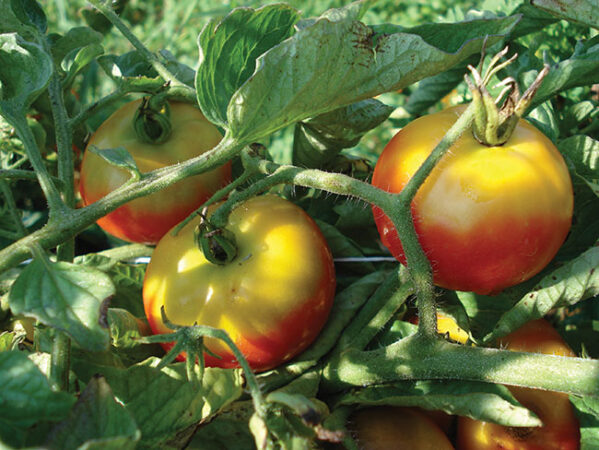
Green shoulder, also known as yellow shoulder or greenback.
PHOTO courtesy of Joan Allen
Green shoulder (a.k.a. Yellow Shoulder, Greenback) is characterized by green or yellow tissue under the peel near the stem of the fruit (shoulder). As the fruit ripens, these areas tend to become more green and yellow and never ripen properly leading to green shoulder. The tissue is often hard even when the rest of the tomato is ripe.
Green shoulder is considered a ripening disorder. Like other ripening disorders it is more common in genotypes lacking the “uniform ripening” gene. Ripening disorders, however, are not strictly genetic because they are associated with a number of environmental factors including high temperatures, light levels, and relative humidity as well as the nutritional status of the crop.
High temperatures reduce photosynthesis and the amount of water and sugars that are transported to fruits and leaves. The lack of photosynthates moving through the phloem to the sink tissues limits the amount of nutrients they receive. This results in a number of deficiencies including potassium (K) deficiency.
The main physiological disorders associated with K deficiency are ripening disorders such as green shoulder. K is thought to play an important role in green shoulder because there’s a higher chance of tomato fruits developing the disorder if they are experiencing K deficiency, and tomato fruit exhibiting green shoulder have lower levels of K than normal fruit.
An early symptom of K deficiency is leaf marginal necrosis. This is characterized by yellowing and browning of the tip of older leaves. K is a highly mobile element in plants because it travels mainly in the phloem. If K deficiency occurs in the plant, it is transported from older parts of the plant (leaves) to younger organs that are growing (fruit). This is why leaf marginal necrosis is usually indicative of K deficiency. Increasing the concentration of K and phosphorus (P) in the nutrient solution will help promote uptake of K and reduce the occurrence of yellow shoulder.
Green shoulder also develops when the fruit is irradiated by direct sunlight during development. Remember that direct sunlight degrades the red lycopene pigment. More specifically, green shoulder is affected by infrared and shortwave radiation. The intensity of red light also has a positive effect on the synthesis of the green/yellow carotenoid pigment that contributes to the yellowing of the fruit tissue.
A multi-pronged strategy is recommended to reduce the occurrence of green shoulder under high temperatures. This includes increased shading of fruit and promotion of K uptake. For example, P supplementation significantly improves growth of upper leaves that provide shade for lower developing fruits, and it promotes uptake of K as well as other nutrients (nitrogen (N), calcium (Ca) and magnesium Mg).
Sunscald
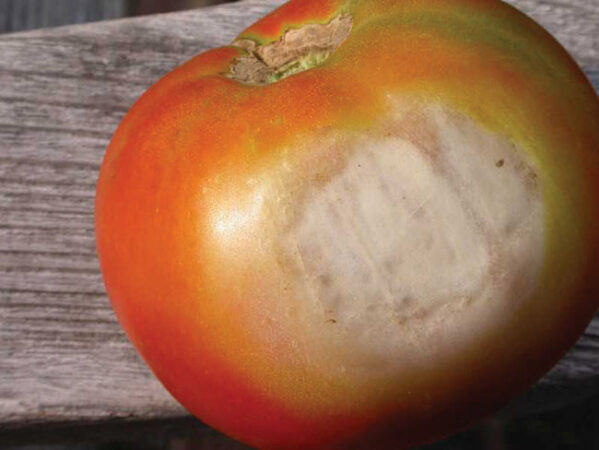
Sunscald, also known as sunburn or sunscorch. PHOTO courtesy of Missouri
Botanical Garden
Besides developing green shoulder, immature fruit irradiated with direct sunlight ripen unevenly so that yellow patches appear on the side of the tomato fruit. This is known as sunscald (a.k.a. Sunburn, Sunscorch).
Similar to green shoulder, the texture of affected areas is leathery and firmer than the surrounding tissues. Also, these yellow areas sometimes have a mottled appearance, and the surface is depressed.
Unlike green shoulder that is thought to have a genetic component, sunscald is associated more with environmental conditions. It is caused when the fruit pericarp reaches temperatures exceeding 40 °C.
How can fruits reach such high temperatures? Fruits that are directly irradiated by strong sunlight with no shade can be more than 10 °C higher than the surrounding air. The degree of injury to the fruit depends on irradiance, spectral quality, temperature, and duration. Promoting upper leaf growth and plant architecture that shades the fruit during growth, as well as applying whitewash on glazing materials to reduce exposure to direct sunlight, are effective ways to reduce sunscald.
Goldspot
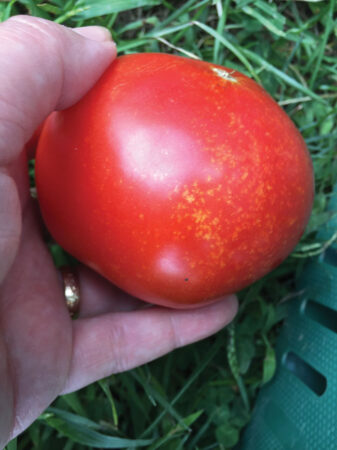
Goldspot, also known as goldspeck.
PHOTO courtesy of Teresa Rusinek
Known as goldspot or goldspeck, yellow specks and flecks are often observed around the calyx and shoulders of mature fruit during summer production. Before tomatoes are mature, these specks appear white in colour and are less abundant in green fruit.
Goldspecks have been identified as cells containing a granular mass of tiny calcium oxalate crystals. These tiny yellowish spots are regular, less than 0.1 µm across and often observed around the calyx and shoulders. Their presence affects the external appearance of the fruit and reduces their shelf-life. In contrast to blossom end rot (BER) that is associated with calcium (Ca) deficiency, goldspot is a result of excess levels of Ca in the fruit. When the greenhouse environment does not promote transpiration through the leaves, like when humidity levels are high, more Ca is transported to the fruit than the leaves. This is because Ca is an immobile element, meaning that it is mainly transported in the xylem with water, unlike potassium (K) that is mainly transported in the phloem with sugars. High Ca/K ratios and increased P levels also promote uptake of Ca and may result in higher Ca concentrations in the fruit and higher incidence of goldspot. Goldspot can be managed by increasing nitrate (NO3) or Mg, or reducing chloride (Cl) or ammonium (NH4) in the feed to reduce uptake of Ca.
This disorder can also be reduced by avoiding susceptible cultivars. For example, cultivars resistant to BER tend to be more susceptible to goldspot because they are more efficient at taking up Ca.
The temperature of the rooting system also has an influence on the rate of absorption of nutrients. For example, increasing the temperature of the rooting system from 14 to 26 °C increases the rate of absorption of Ca and P by 45% and 64%, respectively. Therefore, it is important to prevent the temperature of fertigation solution from rising too high. There’s a fine balance that must be struck between providing the crop with enough Ca to avoid BER, and not too much Ca such that it causes goldspot.
Conclusions and Recommendations
Many of the physiological disorders discussed here can be avoided by shading the greenhouse and/or fruit in the summertime. This can be done by coating the greenhouse exterior with glazing products to reduce the amount of light entering the greenhouse, and/or promoting upper leaf development to shade lower developing fruit.
Shading the developing tomato fruit reduces its temperature which promotes cell division and growth. This in turn allows the fruit cells to withstand the high turgor pressure they are under and reduces the chances of cracking. Shading tomato fruit also avoids direct sunshine irradiation, which was also reported to be effective at reducing cracking.
Reducing light levels also reduces the photosynthesis rate and the inflow of photosynthetic products into the fruits. By suppressing the amount of photosynthetic products and water flowing into the fruit, the occurrence of cracking is reduced. But of course, this must be balanced with providing enough light for the crop to maximize production.
Other techniques that have shown to be effective against cracking include controlling humidity by fog cooling and the use of ultraviolet (UV)-absorbing film. Reducing the fruit temperature and direct sunlight by shading also promotes lycopene accumulation which reduces ripening disorders like yellow shoulder and sunscald.
Fadi Al-Daoud, PhD, is the greenhouse vegetable specialist at the Ontario Ministry of Agriculture, Food and Rural Affairs. Xiuming Hao, PhD, is a research scientist at Harrow Research and Development Centre, Agriculture and Agri-Food Canada. They can be reached at fadi.al-daoud@ontario.ca and xiuming.hao@canada.ca
Print this page